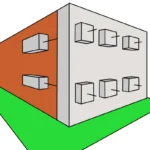Reinforced Concrete: A Alliance of Strength
Reinforced concrete is a ingeniously designed construction material that combines two fundamental components: concrete and reinforcing steel. This unique combination harnesses the inherent strengths of each of these materials to create a structure that is stronger and more versatile.
Composition of reinforced concrete:
Concrete
Concrete, in its basic form, is composed of three main ingredients: Portland cement, aggregates (sand and gravel), and water. Portland cement is a fine powder that, when mixed with water, forms a paste that acts as the binder that binds the aggregates. This paste surrounds and coats the grains of sand and gravel, creating a solid and cohesive mass. When this mixture hardens and dries, it becomes concrete.
The characteristic strength of concrete is its ability to withstand compressive loads, i.e., forces that act to crush or compress it. This strength makes it ideal for parts of a structure subjected to vertical loads, such as the foundations of a building or the columns of a bridge.
However, concrete alone is vulnerable to tensile and flexural forces, meaning it can break or crack when stretched or bent. This is where the second component of reinforced concrete comes into play: reinforcing steel.
Reinforcing Steel
Reinforcing steel, usually in the form of corrugated steel bars or steel mesh, is strategically placed within the concrete mass before it hardens. These bars or meshes serve as structural reinforcement and provide concrete with the ability to resist tensile and flexural forces. Steel is exceptionally strong in tension, meaning it can stretch and bend without breaking, characteristics that concrete alone does not possess.
The combination of concrete and reinforcing steel creates a unique symbiosis in which concrete protects steel against corrosion and fire, while steel provides additional strength to concrete, enabling it to withstand loads that would otherwise be unsustainable.

Uses of reinforced concrete:
Reinforced concrete is used in a wide variety of applications, including
High-Rise Buildings: Reinforced concrete is extensively used in the construction of skyscrapers and tall buildings. It is employed in columns, beams, and slabs to provide the necessary structural strength to support vertical and lateral loads. Its durability and ability to withstand heavy loads make it a common choice in skyscraper construction.
Bridges: Structural components of bridges, such as beams, piers, and decks, are often constructed with reinforced concrete. This material can resist the compressive and tensile forces generated by vehicular traffic and extreme weather conditions, making it an ideal choice for bridge construction.
Dams and Hydroelectric Works: Dams and hydroelectric plants require materials resistant to water and capable of supporting extreme loads. Reinforced concrete is essential in the construction of hydroelectric structures as it can withstand water pressure and provide a solid foundation for turbines and other equipment.
Roads and Pavements: In the construction of roads and highways, reinforced concrete is used to create durable surfaces that can withstand the weight and abrasion of constant vehicular traffic. These surfaces remain relatively smooth and pothole-free for extended periods, reducing the need for maintenance.
Marine Structures: Ports, docks, and marine structures benefit from reinforced concrete due to its resistance to corrosion caused by saltwater. Concrete is a common choice for building structures that must withstand the forces of the ocean and vessels docking on them.
Storage Structures: Silos, storage tanks, and warehouses are often constructed with reinforced concrete due to its ability to safely and durably contain bulk materials, liquids, and chemicals.
Tunnels and Metro Stations: In underground projects, such as tunnels and metro stations, reinforced concrete is used to create robust structures that can withstand soil pressure and constant traffic of trains and passengers.
Retaining Walls: Reinforced concrete retaining walls are used to stabilize slopes, prevent landslides, or create terraces on steep terrain.
Architectural Elements: In addition to its structural use, reinforced concrete is also used in architectural elements such as facades, stairs, and decorative details in buildings.
Water and Sewer Infrastructure: Pipes, inspection wells, and water and sewer treatment structures are often built with reinforced concrete due to its ability to resist corrosion and ensure long-term durability.
Advantages and Disadvantages of Reinforced Concrete:
Advantages
High Strength: One of the main advantages of reinforced concrete is its ability to withstand heavy loads in compression and tension. This makes it suitable for a wide range of structural applications, from tall buildings to bridges and dams.
Durability: Reinforced concrete is known for its long-term durability. It is corrosion-resistant, making it suitable for humid and saline environments, such as marine structures and sewage works. Additionally, its lifespan is significantly longer than some other construction materials.
Design Versatility: It can be molded into a variety of shapes and sizes, allowing great flexibility in architectural and structural design. This is especially useful for projects that require specific shapes or decorative elements.
Low Maintenance: Reinforced concrete generally requires little maintenance throughout its lifespan. This reduces long-term maintenance costs and makes it an economical choice.
Fire Resistance: Reinforced concrete is fire-resistant, making it suitable for buildings that must meet rigorous fire safety standards.
Sustainability: Reinforced concrete can be recycled, contributing to environmental sustainability and the conservation of natural resources.
Disadvantages
Weight: Reinforced concrete is a dense and heavy material, which may require larger and more expensive foundations. This can increase construction costs and limit its use in structures where weight is a concern.
Initial Costs: Although it may be cost-effective in the long run due to low maintenance, reinforced concrete often involves higher initial costs compared to some other construction materials.
Cracking Vulnerability: While it is robust, reinforced concrete can be vulnerable to cracks, especially when subjected to heavy loads or seismic movements. These cracks can weaken the structure over time if not managed properly.
Setting Time: Reinforced concrete may have a relatively long setting time, which can extend the time needed to complete a construction project.
Environmental Impact of Cement Production: The production of cement, a key component of concrete, can generate a significant amount of carbon dioxide emissions, contributing to climate change. However, efforts are underway to develop more sustainable cements and reduce this environmental impact.
Reinforced Concrete Construction Process
The construction process of reinforced concrete involves a series of carefully planned and executed steps to ensure the quality and structural integrity of the project. Here is an overview of the main steps in the reinforced concrete construction process:
Design and Planning: Before construction begins, it is essential to create a detailed design of the structure, including specifications for the type of concrete to be used, the dimensions of structural elements, and the placement of reinforcing bars. This design must comply with local and national building codes.
Site Preparation: The construction site must be properly prepared. This includes leveling the ground, removing any obstructions or vegetation, and creating a solid foundation for construction.
Reinforcement Assembly: Before pouring the concrete, the steel reinforcement is installed according to the design specifications. This involves placing reinforcing bars in the proper locations and tying them with wire to ensure they are in the correct position and maintain the proper spacing.
Formwork: Formwork, or molds, is constructed around the areas where the concrete will be poured. Formwork can be made of wood, metal, or synthetic materials and must maintain the desired shape and dimensions of the structure.
Concrete Pouring: The concrete is carefully poured into the formwork. Segregation of the concrete during the pouring process, meaning that aggregates should not separate from the cement and water, must be avoided.

Compaction: After pouring, the concrete is compacted to eliminate air pockets and ensure that the material fills all the spaces in the formwork. This can be achieved through vibrating the concrete or using compaction equipment.
Curing: Concrete requires a curing period to gain strength. During this stage, specific humidity and temperature conditions are maintained to allow the concrete to harden and develop its optimal strength. Curing may take several days or weeks.
Formwork Removal: Once the concrete has reached sufficient strength, the formwork is carefully removed to avoid damaging the newly formed structure.
Finishing: Final finishes are applied to the concrete surface according to project specifications. This may include smoothing, texturing, or applying protective coatings.
Inspection and Quality Control: A thorough inspection is conducted to verify that the structure meets the quality and safety standards set in the design. Strength and durability tests, as well as checks for cracks and other defects, are performed.
Commissioning: Finally, the structure is commissioned according to its intended purpose. This may include loading weight, occupying buildings, or using infrastructure, depending on the project.
Types of Reinforced Concrete
One of the reasons it is so versatile is that there are several types of reinforced concrete, each designed to meet specific requirements for strength, durability, and use. Below, we will explore some of the most common types of reinforced concrete and their applications.
Fiber-Reinforced Concrete: Fiber-reinforced concrete incorporates steel, glass, polypropylene, or even natural fibers into the concrete mix. These fibers act as additional reinforcement and enhance the tensile and flexural strength of concrete. It is commonly used in pavements, industrial floors, and prefabricated elements to resist stresses caused by shrinkage and thermal expansion.
Steel Fiber-Reinforced Concrete: This type of reinforced concrete uses steel fibers instead of traditional steel bars. Steel fibers are short and dispersed in the concrete mix, improving the tensile strength and ductility of the material. It is useful in applications such as tunnel construction and reinforcement of thin walls.
Prestressed Concrete: In prestressed concrete, steel bars are stretched before pouring the concrete. This creates initial compression in the concrete, enhancing its ability to resist subsequent loads. It is used in large-span beams and slabs, such as bridges and high-rise buildings, where high strength is required.
Post-Tensioned Concrete: Unlike prestressed concrete, in post-tensioned concrete, steel bars are tensioned after the concrete has set. This process allows adjusting the tension according to specific structural needs, making it ideal for applications where design flexibility and long-term strength are required, such as bridges and storage tanks.
Reinforced Concrete with Welded Wire Mesh: Instead of individual steel bars, this type of reinforced concrete uses welded wire mesh. It is common in the construction of prefabricated elements, retaining walls, and pavement reinforcement.
Reinforced Concrete with Glass or Polypropylene Fiber: These types of reinforced concrete are corrosion-resistant and are used in environments where exposure to water and chemicals is a concern, such as pools and chemical storage tanks.
Reinforced Concrete with Natural Fibers: In this type of concrete, natural fibers like coconut or hemp are used as reinforcement. It is a sustainable choice and is often used in eco-friendly construction applications.
Conclusion
Reinforced concrete represents an intelligent alliance between two fundamental materials, concrete and reinforcing steel, resulting in an exceptionally strong and versatile combination. This symbiosis allows tackling a wide range of construction challenges and overcoming structural obstacles that would otherwise be insurmountable.
The composition of reinforced concrete, with its inherent ability to withstand compressive loads, combines with the toughness of reinforcing steel to resist tensile and flexural forces. This union offers durability, fire resistance, and design versatility, making it a preferred material in a variety of applications, from skyscrapers to dams and marine structures.
Engineers and architects continue to innovate and develop new types of reinforced concrete, adapting their properties to meet the specific needs of particular projects. Whether in the construction of iconic buildings, crucial bridges, or essential infrastructure, reinforced concrete is a fundamental piece of our built environment.
However, we cannot ignore its disadvantages, such as its weight and initial costs, as well as the environmental impact of cement production. The construction industry strives to address these challenges and develop more sustainable and efficient solutions.
In summary, reinforced concrete is a strength alliance that has transformed the way we build and live. Its ability to confront structural challenges and its design versatility continue to drive advancements in engineering and architecture, contributing to sustainable development and the creation of a safer and more durable built environment.







Related
Gravity Retaining Walls
What are Anchored Retaining Walls?
Methods for Paver Calculation – Civil Engineering